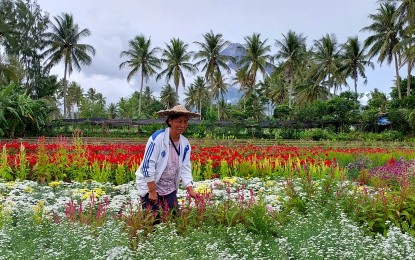
BEAUTY IN BLOOM. With Mayon Volcano providing a stunning backdrop, flower farm owner Eleanor Alaurin on Monday (Oct. 23, 2023) checks on her beautiful blooms in Daraga, Albay which she intends to harvest on Oct. 29 in time for the 'Undas' or All Saints’ and All Souls' Day celebrations. Alaurin expects an uptick in the demand for flowers as Filipinos troop to the cemeteries to visit their departed loved ones. (PNA photo by Gladys Serafica)
DARAGA, Albay – With Mayon Volcano displaying signs of restiveness, spewing red hot lava down its slope just days before All Saints' Day and All Soul's Day, flower farm owner Eleanor Alaurin is in a race against time.
"We hope to harvest all the flowers by Oct. 29 in time for the 'Undas' to generate income just in case we need to go back again to the evacuation centers," Eleanor said in the vernacular.
As just a team of two managing a half-hectare farm located within the seven-kilometer extended danger zone of the volcano, Eleanor, 52, and her husband, Danilo, 55, are working double time to cash in on the high demand for cut flowers these holidays.
"If we sell all our flowers, we will probably get at least PHP50,000," she said.
On her serene and bucolic farm in Barangay Matnog of this Albay town, the Alaurin couple has adopted the methods of integrated farming.
Colorful blooms of chrysanthemums, cockscomb, celosia, aster and gomphrena sway gently with the breeze alongside verdant rice stalks.
Unlike other farmers, they prioritize ornamental farming over rice farming because "it is more profitable."
"We only grow rice since the ornamental plants should be rotated with other crops to conserve soil fertility. We really do not earn much from our rice production," she added.
Luz Mapa, chairperson of the municipal agriculture and fisheries council of Daraga, said that compared to rice farming, flower farming yields higher profit margins given its shorter growing cycle and higher market value, especially during special occasions.
In fact, Mapa estimates that a single flower bed teeming with chrysanthemums can yield an income of PHP10,000 during the peak season. That is, excluding other revenue streams from value-added products like floral arrangements and agrotourism.
Farmer-florists can also fetch at least PHP200 to PHP300, and even as high as PHP800 to PHP1000 for arranged bouquets depending on the customer’s preference.
While the floriculture industry holds so much economic potential, planting and growing flowers for profit, however, is no easy feat.
But the Alaurin couple has found just the right blend of attitude, timing and strategy.
"In my 20 years of experience, I have learned that maintaining a flower farm takes so much hard work," Eleanor said.
Perhaps even more now that they are no longer in their prime, although body pain and advancing age could not dim their devotion to their flower garden, she said.
With a kind of diligence comparable to that of ants, both Eleanor and Danilo remain hands-on in their little patch of heaven, working from sunrise to sundown against the backdrop of the majestic Mayon Volcano, well aware that their livelihood is vulnerable to the ravages of weather.
"When you love what you do, you lose track of the time," she said with a twinkle in her eye.
For this season, they started planting the flowers around June, making sure to harvest them at their peak bloom stage in time for Undas.
When it comes to the choice of flowers, the couple tends to grow with an eye toward economics, aligning their production with customer demands.
Given that flowers have a limited shelf life, they have also established connections with other florists, wholesalers and retailers, even utilizing social media to drive foot traffic to their humble farm.
"My only dream is to be able to send all my children to school with this kind of livelihood. Seven months from now, my youngest will be graduating,” Eleanor proudly said.
Market demand
On All Saints' and All Souls' Days, all roads lead to Barangay Matnog, the local flower capital of this town.
However, Dennis Bon, village chief, said the floriculture business in their village thrives all year round because “flowers grace every occasion in the Philippines,” although it peaks during big calendar holidays such as Valentine’s Day, Mother’s Day, Holy Week and Undas.
To ensure a steady stream of sales, some flower farm owners tie up with local funeral homes, while others sell their ornaments in the local market and in nearby towns such as Polangui and Ligao.
“Ornamental gardening has become a natural pastime here. In every home you visit, there will always be a garden, or potted plants if there is no space for a yard,” he said in the vernacular.
While Matnog’s flower production remains relatively small, it is gradually flourishing.
“This coming May 2024, in time for our annual fiesta celebration, we will have our first Burak (Flower) Festival. We hope that through this, we can further promote our flower farms and the artistry of our local florists,” the village chief said.
As Filipinos head to the cemeteries to offer prayers, candles and flowers for the eternal repose of the souls of their departed loved ones, the Alaurin couple proves that business can thrive on the day of the dead.
“There is money in flower farming. But it takes a lot of work and, of course, a green thumb,” Eleanor said. (PNA)
